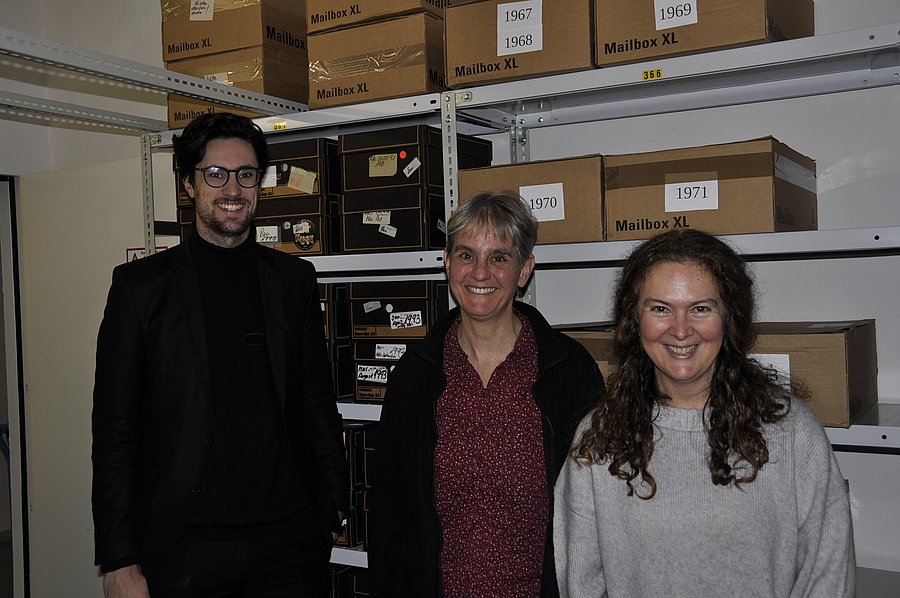
The Kurt Keil Archive
Philipp Roling, Dr. Friederike Jesse, Dr. Carmen Pérez González / History of Science and Technology/ University Archive
Photo: UniService Transfer
When you exhibit Kurt Keil, you present the city
Photo historian Dr. Carmen Pérez González curates the collection of photographer Kurt Keil in the university archive with students
In the beginning was the water damage. The floods in Wuppertal in 2021 also caused the cellar of the family of photographer Kurt Keil, who died in 2020, to fill up, where the entire archive of the long-time employee of the Westdeutsche Zeitung had been housed until then. As alternative storage space was not available, the family asked the university archivist at the time, Dr. Joachim Studberg, for help, who quickly ensured that the extensive collection could be secured at the university for the time being. Since then, this estate has rested on the shelves of the university archive. Soon after Dr. Friederike Jesse took over the management of the archive in spring 2023, she became aware of the collection. Professor Dr. Volker Remmert put her in touch with photo historian Dr. Carmen Pérez González, who has a teaching position in the history of science and technology. The scientists met for the first time in June 2023. "When I saw the collection, I was of course overwhelmed," says Pérez González, "because as a photo historian, you love nothing more than an uncurated collection. And I immediately had an idea." She offered an exercise to inventory the existing material together with her students, led by Philipp Roling. Pérez González is predestined for this task. She has been head of the FBS Foundation in Segovia, Spain, since October 2023 and is preparing one of the largest collections of stereoscopic photography for science and research. "We don't even know exactly how extensive Kurt Keil's collection is yet. The fact is that the collection covers the period from 1967 to 2007," she reports enthusiastically, "and contains countless negatives, exhibits from an earlier exhibition, newspaper cuttings and contact prints, as well as images in various formats. There are also numerous cameras that Keil has used over the years, all of which are still with the family."
The task is enormous. "The number of boxes containing the negatives alone is considerable, and we also have to sort them because the original labels don't always match the contents," says Roling, describing the situation. This is often very tiring, Pérez González states, but this task is fundamental, without it no analysis can take place. For this reason, the photo historian's small practice team has chosen to focus on the years 1967 to 1969.
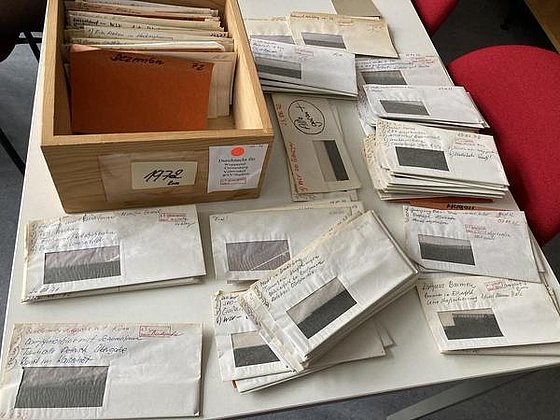
Negative envelopes from the Kurt Keil Collection Photo: Carmen Pérez González
An inspiring career
Together with the students, Jesse, Pérez González and Roling have already been able to visit Keil's family and obtained a lot of valuable information about the photographer and his collection. "Kurt Keil wasn't always a photographer," says Roling, "he was originally a plumber and then changed to his dream job through his passion by sending photos to the Westdeutsche Zeitung. That alone is an inspiring story."
The photo collection - pure city history
With over five decades, from 1967 to the 2000s, the time frame of Kurt Keil's work in Wuppertal was enormous. The photographic material is pure city history. "When you look at all the negative envelopes, you can see the enormous range through the titles of the captions. He also covered smaller events in Langerfeld or Vohwinkel and he was out and about every day," reports Roling. "There are envelopes for Christmas and Easter and only rarely a gap where there was nothing for a week," and Pérez González adds: "Sometimes there are three different envelopes for one day because he had several jobs." His estate also includes various folders that he had created for other book projects.
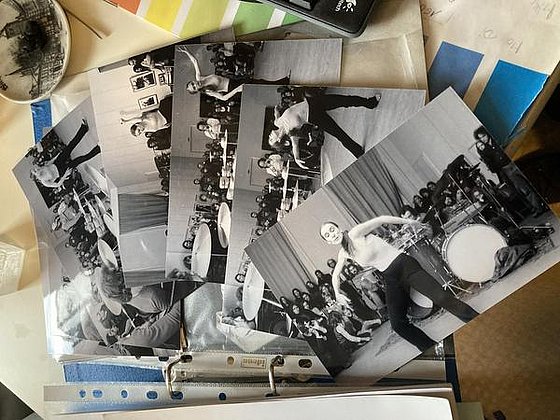
Photo collection Kurt Keil: Pictures Pina Bausch Photo: Carmen Pérez González
Keil was present at almost all of WSV's home games
Kurt Keil had a special passion for Wuppertaler SV, where he could always be seen at home matches in the Zoo stadium. He followed the soccer club's eventful development from the very beginning. And it's not just the university researchers who are interested, says Jesse. There have already been inquiries from a sports photographer who has looked through the archive especially for WSV. "The family even has entire CDs on which Kurt Keil photographed individual games in their entirety and documented 90 minutes, so to speak."
A special photo motif: Johannes Rau
And then, of course, there are the many meaningful pictures of places, buildings, events and even celebrities. Pérez González says spontaneously: "My favorite motif is Pina Bausch". "Another person who keeps popping up is Johannes Rau," adds Roling, "with whom Kurt Keil was also in constant contact. He also sent his book about Johannes Rau to him, who proofread it in detail and sent it back with lots of comments." The collection files are still looking for this corrected book, which has many sticky notes in it, because it would make a nice exhibit for a possible exhibition. "It was probably the case," explains Jesse, "and I've heard this from several sources, that Kurt Keil was something like Johannes Rau's court photographer and that he explicitly requested that Keil take the photos on certain occasions." The list of celebrity photographs is very long and includes political figures such as Erich Honecker, Helmut Kohl, Hans-Dietrich Genscher and Angela Merkel as well as showbiz stars such as Hans Rosenthal, Rudi Carrell and Udo Lindenberg.
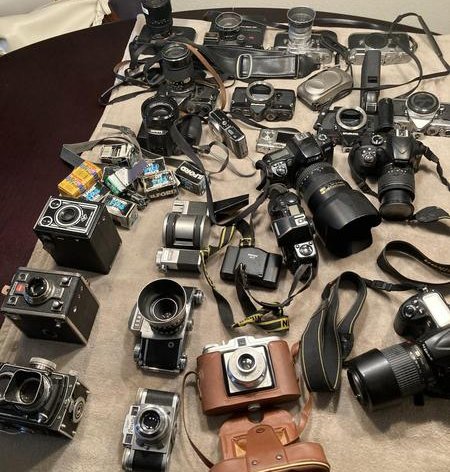
Cameras from the Kurt Keil Collection
Photo: Carmen Pérez González
The cameras
Pérez González also wants to look through Kurt Keil's many cameras, which are still with the family, because it is important to be able to describe which pictures were taken with which camera. Although Kurt Keil liked Leica cameras best, he also worked with Nikon later on, when he moved towards digital photography. "You can see the chronology of the cameras very clearly, and that is so important for the development of photojournalism," explains the trainer. "The photographer also had to adapt to the new technologies."
An exhibition is planned
The photo historian's first exercise is a start, more exercises will follow, because curating also needs to be learned. "I let the students develop their own ideas, but I'm constantly asking questions. Every collection has its own history and you have to develop it in its own context. There is no one-size-fits-all approach, but we approach the topic by asking questions. We catalog and then gradually find ways of approaching a particular topic," says Pérez González. This long journey could then also lead to a first exhibition. "The most important thing is this man's work. The processing of the material that he left to posterity. That's why, in my opinion, the first exhibition should show his entire oeuvre, i.e. the cameras, the negatives, the photos and also the folders with the various book ideas he had. When you present him, you present the city. And the question when curating an exhibition today is, how do you do it in 3D? Maybe there will be a darkroom in the exhibition, because of course he had one," says the photo historian.
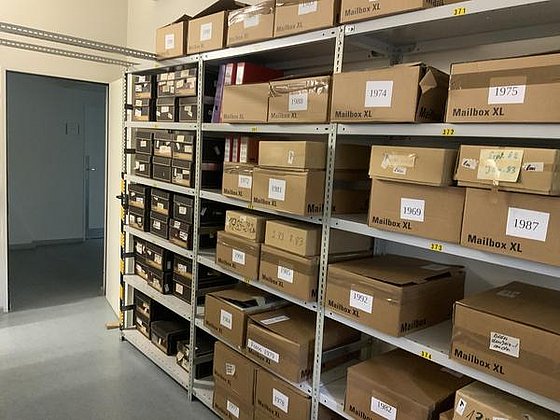
Extract from the Kurt Keil Collection in the university archive
Photo: Carmen Pérez González
As the work is so extensive, further exhibitions could follow, which would then deal with specific topics. The archivist says: "Be it Johannes Rau, Pina Bausch, the suspension railroad or events from the city. There is also a lot of material on Sonnborner Kreuz, which is the history of the city and transportation, where people had to be relocated. And that, in turn, is of course also interesting for students as a final thesis: you can deal with a specific event and then find the photographs here."
The university archive is located on the Freudenberg campus in building FD and can be visited by appointment at archiv[at]uni-wuppertal.de.
Uwe Blass
Dr. Carmen Pérez González is an astrophysicist, photo historian and lecturer in history at the School of Humanities and Cultural Studies at the University of Wuppertal. Philipp Roling studies Industrial Design at the University of Wuppertal. Dr. Friederike Jesse is head of the University Archive at the University of Wuppertal.
